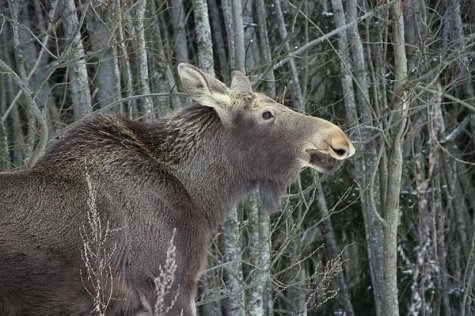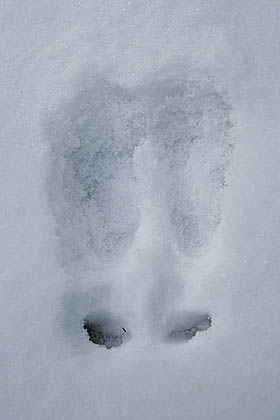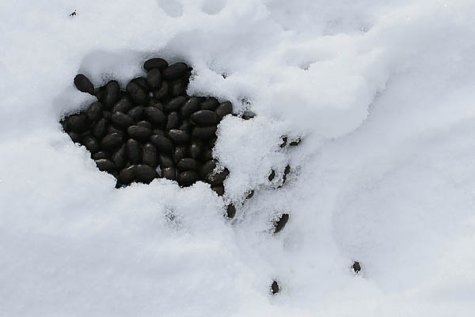How does climate affect elks?
Interview: Sven Paulus, ajakiri.ut.ee
Photos: Arne Ader
Translation: Liis
Elk
Elk; Eurasian elk; moose (North America) Põder
Rauno Veeroja of the game surveillance department of the Estonian Environment Information Centre (Keskkonnateabe keskus) has studied how environmental conditions affect the dynamics of our elk population. For those who have had little experience of hunting it may come as a surprise that in Estonia nearly half the elk population is shot every year. If this were not done our forests would be seriously damaged.
Did this come from field work?
The whole doctoral thesis primarily relies on data from the elks shot in Estonia. In addition there are surveillance data which are useful as indicators of the elk population density. The greater part are biosamples, collected from shot animals, that the hunters must submit each year. So for instance each year the lower jawbone is taken from about 80% of the killed elks in order to determine their age. In connection with this we also measure the length of the jawbone, which in the case of young animals is a characteristic indicator of growth. Jüri Tõnisson started collecting these data already in 1987, and did so from the whole of Estonia.
The whole doctoral thesis primarily relies on data from the elks shot in Estonia. In addition there are surveillance data which are useful as indicators of the elk population density. The greater part are biosamples, collected from shot animals, that the hunters must submit each year. So for instance each year the lower jawbone is taken from about 80% of the killed elks in order to determine their age. In connection with this we also measure the length of the jawbone, which in the case of young animals is a characteristic indicator of growth. Jüri Tõnisson started collecting these data already in 1987, and did so from the whole of Estonia.
The core of my doctoral work however is data on the fecundity of elks that originate from analyses of reproductive tracts of shot elk cows. Anne Kirk, supervisor of my BSc and MSc studies, started collecting these data already in 1993 and I joined in with corresponding work in 1999. Now the annual analyses of the reproductive tracts of elk cows has become a vital part of the elk surveillance and the results of this work provide valuable information about the state of the elk population and in addition allow quite accurate predictions to be made about the generation to be born in spring. Thus the information on the fecundity of elks is a important part in determining the recommended hunting quotas.
If the state of elks in Estonia were assessed – how are they?
During the last hunting season the population density of elks was slightly higher than what we might want to agree on. There is quite a lot of grumbling from foresters, so during the last season clearly more elks were shot compared to recent previous years. But in general the state of elks is quite good, the fertility indicators are good and stable. Parameters characterising growth such as the length of the jaw bone was better for calves this year than after two difficult winters. These brought our roe deer population down to a very low level, but for elks an increased natural mortality rate was not noted. In general our elks have fared quite well during the last ten years.
How large is our present elk population roughly?
An estimated number is around 12 000. This is a winter indicator, from before the start of the next calving period at the end of April. In May there is an addition of new calves and the population again increases. In the case of elks the winter population is estimated which is after the hunt and before the calving. In general the estimate of the abundance of elks is quite accurate compared to all other game animals.
An estimated number is around 12 000. This is a winter indicator, from before the start of the next calving period at the end of April. In May there is an addition of new calves and the population again increases. In the case of elks the winter population is estimated which is after the hunt and before the calving. In general the estimate of the abundance of elks is quite accurate compared to all other game animals.
But to what extent are they hunted?
Last year a little more than 5000 animals were shot. If 12 000 is the basic population then, depending on the year, 5000-6000 calves may be added, depending on the survival of the calves. Of course the natural mortality rate comes into this too. Based on practical experience the optimal number of elks may be 10 000-11 000 individuals. This is of course a so-called social optimum governed by various interests and wishes of humans. Hunting should ensure that there will be no areas where elks are too densely together, because then damage is guaranteed. Given a uniform distribution this magnitude will not do much harm, forests and foresters should be reassured, and hunters have enough to hunt. At the moment it seems that in the opinion of forest owners the abundance of elks could be clearly lower than this too.
Elk print
How does winter weather affect elks?
Various studies have shown the negative effects of severe winters on the survival rates and condition of different ungulates. But at the same time it has been conjectured that warmer than average winters may affect individuals and their fitness negatively. This has been discussed particularly in recent years in connection with the global warming problem.
In my doctoral work I studied how winter weather conditions affect the body growth of elks, various fecundity parameters and conception time. Since it has been shown in different studies that even at the foetus stage some effects from the external environment are transmitted to the offspring by way of the mother’s condition, thus affecting the condition and success of the offspring later in life, I investigated, in addition to the immediate impact of winters, also delayed and cumulative effects. From data analysed by me and my colleagues both direct and indirect effects of winters have been identified. As expected negative effects of severe - cold and snow-rich - winters were detected in the studied parameters. At the same time negative effects of warmer than average winters were confirmed.
Assuming that the animals living here have adapted to the long-term average of our environmental conditions, we also examined the variability of winter conditions or the effect of deviations from average on the body size and fertility of elk cows. We did find that the effect of this so called winter changeability indicator on life-history parameters was much stronger than that of the primary climate indicators. Or put differently, there was a negative impact from colder as well as warmer than average winters.
I have used two different large-scale weather indicators throughout. One is the North Atlantic Oscillation phenomenon that is much used in various ecological studies, and affects winter weather conditions in large parts of North Europe. Our climate researchers too have shown its relationship with our winters. As an alternative we used the maximum ice coverage (extent) of the Baltic as characteristic of the winter severity, which correlates well with the Estonian average winter air temperatures as well as the snow cover duration and maximum depth. This indicator also has a significant effect on the springtime weather conditions. The extent of ice on the Baltic was clearly more successful in our models.
How can this negative impact show?
The elk as a species is quite well adapted to complex winter conditions, and tolerates frost quite well. Due to its long legs the snow cover in general begins to have serious restrictions on the movements of elks only when the snow cover thickness exceeds half a metre. The situation is of course made worse by a strong ice crust on the snow and snow compaction.
The elk as a species is quite well adapted to complex winter conditions, and tolerates frost quite well. Due to its long legs the snow cover in general begins to have serious restrictions on the movements of elks only when the snow cover thickness exceeds half a metre. The situation is of course made worse by a strong ice crust on the snow and snow compaction.
Young animals are most sensitive to winter conditions. While in the North American, Siberian and Scandinavian areas, with clearly more severe climate than ours, severe winters are accompanied by a large mortality among vulnerable individuals, the effects of more severe winter conditions in our area show primarily in decline of the growth of juveniles and in fertility indicators. The results of one of the studies underlying my dissertation also showed the effect of winter on the fertilisation period of elks. After severe winters the rut period of elks was delayed. After cold winters the vegetation period also starts later, due to which calving can also be slightly delayed. Because of the fresh food scarcity and the poorer condition caused by winter the cows cannot at once produce enough high-quality milk, so the development of the new-born is slower. Following the initial delay and the poorer condition of the cow as well as the offspring, the next heat period of the cow can also be delayed.
The negative effects of warm winters can clearly be more difficult to understand than the negative impact of severe winters. For example it may come as a surprise for many people that warmer than normal winters can cause problems for elks in getting rid of excess body heat. Thermal stress results in loss of appetite, and the body begins to use up energy to get rid of heat. Likewise weather conditions swinging between plus and minus degrees can have a negative impact on the quality of the food plants for ungulates. Problems can also arise from a wider spread of parasites and pressure from non-native species. In our conditions the red deer is slowly moving in from the south, and is a species partly competing with elks.
Can some conservation-related recommendations be extracted from the thesis?
As regards climate, the work directs attention to the fact that effects in different directions should be taken in account. In the last decade there has been much talk about few things being linear in our world, In case of extraordinary environmental conditions we can expect to see some negative aspect on the species that we protect or study. Not directly related to the climate, but an important part of the work is the fact that the conception time may have a significant effect on the offspring: from precisely when the conception took place – in the beginning, middle or end of the heat period.
As regards climate, the work directs attention to the fact that effects in different directions should be taken in account. In the last decade there has been much talk about few things being linear in our world, In case of extraordinary environmental conditions we can expect to see some negative aspect on the species that we protect or study. Not directly related to the climate, but an important part of the work is the fact that the conception time may have a significant effect on the offspring: from precisely when the conception took place – in the beginning, middle or end of the heat period.
Since the polygamous ungulates are the type of mammals whose males must grow larger than the females, and fight between themselves for the females, the males should be the ones to gain the most from an early start. For male offspring a good birth weight is significantly more important, also a favourable starting position and achieving a body mass as large as possible until autumn. Then they will have an advantage in relation to their age group. The results in my dissertation confirm this: elk cows fertilized in the beginning of the heat period had significantly more male offspring and more multiple embryos also occurred.
Rauno Veeroja’s dissertation is available HERE; in English with Estonian summary, 48 pages (app 22 pages text), extensive literature list
Elk droppings











